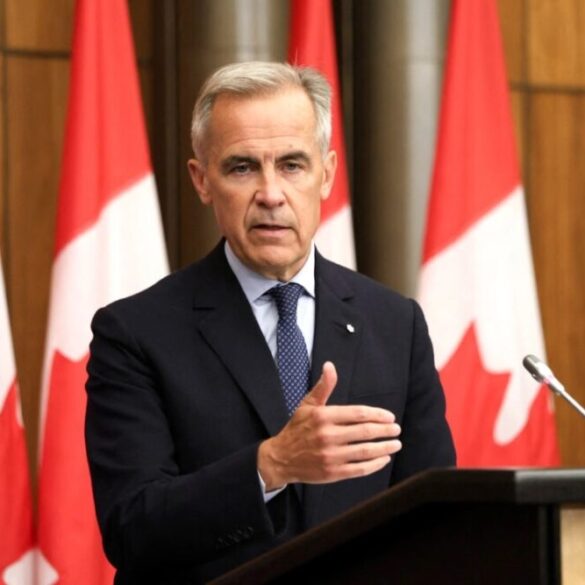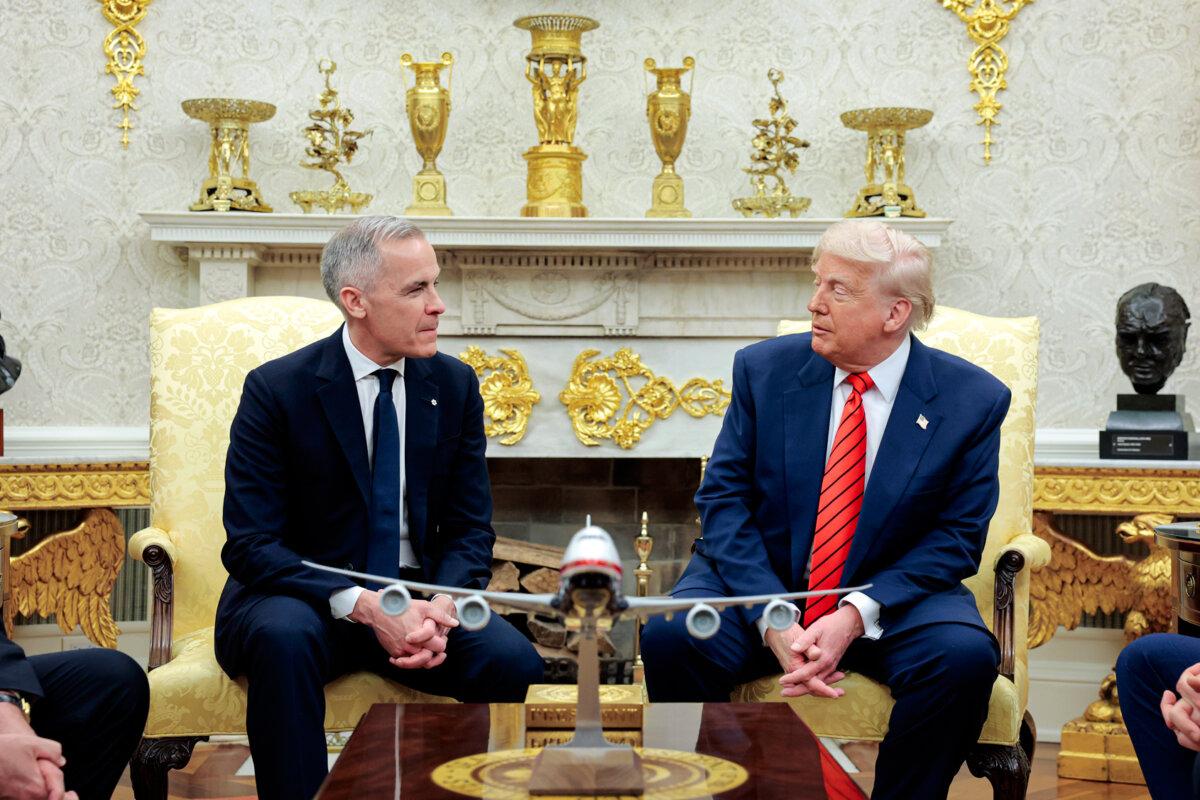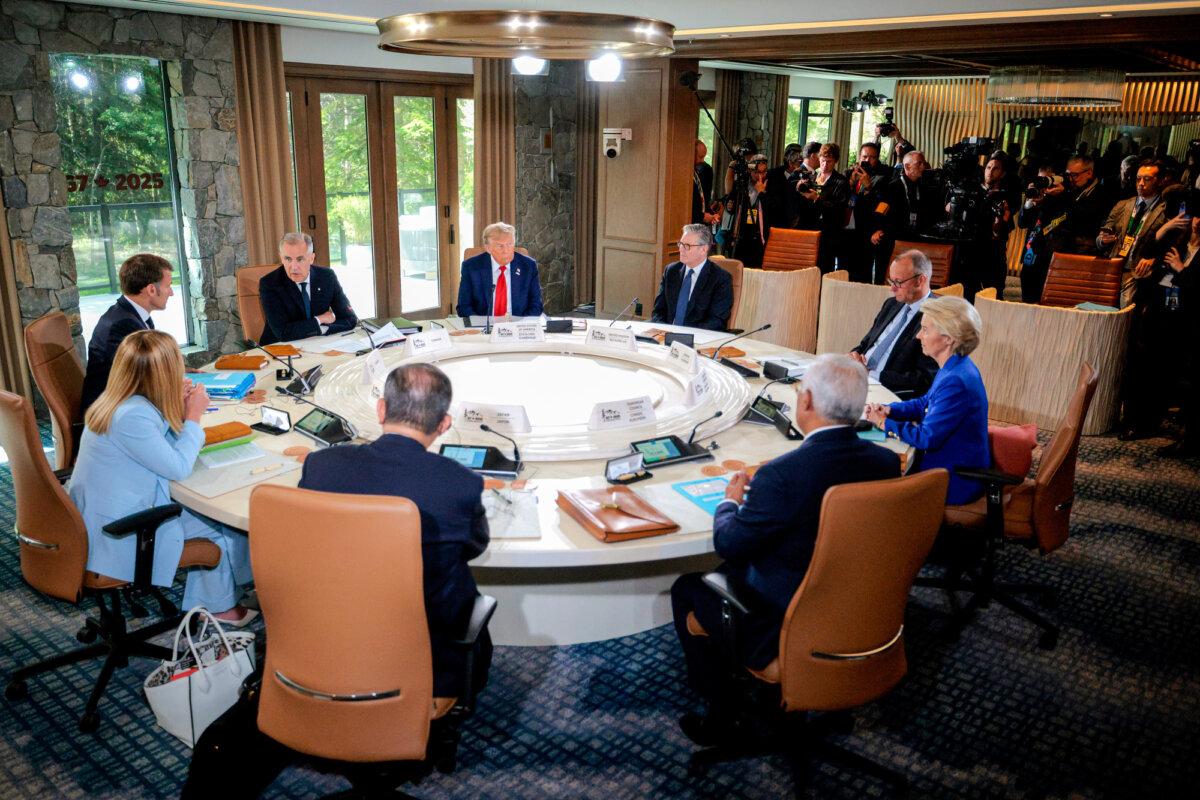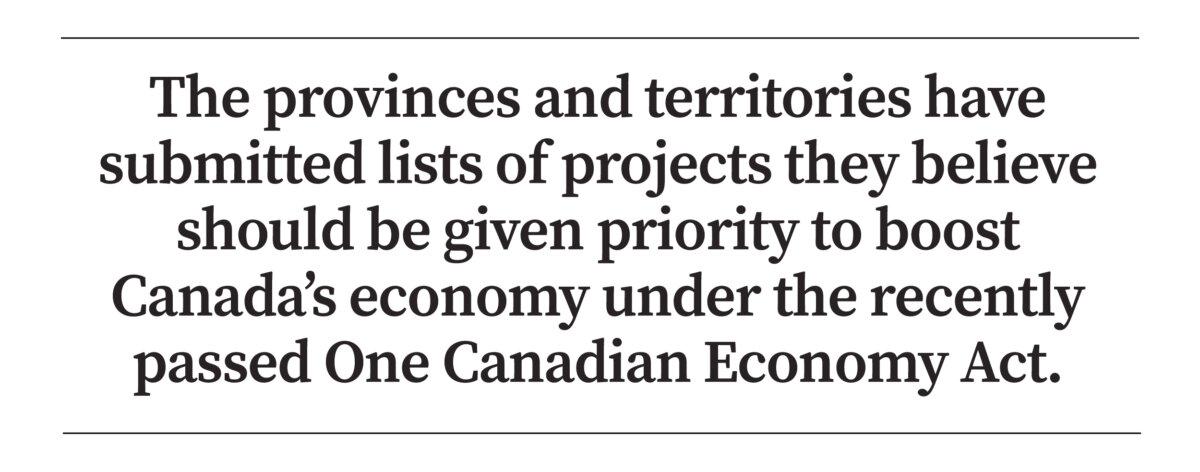A look at Carney’s first 100 days in office after winning the election on April 28.

Canadian Prime Minister Mark Carney speaks during a press conference at the National Press Theatre in Ottawa, Ontario, Canada, on July 30, 2025. Dave Chan/AFP via Getty Images
Prime Minister Mark Carney has seen a whirlwind of activity in his first few months in the role, from dealing with U.S. President Donald Trump to announcing huge spending increases for the military, as well as implementing tax cuts and passing legislation to expedite the construction of major projects, while fielding criticism from Opposition and some provinces for maintaining some of the energy-related legislation.
Here’s a look at some of the most important happenings since Carney’s April 28 election victory.
Relationship With Trump
Carney ran a campaign focused on challenging Trump’s tariffs and his comments about making Canada the 51st U.S. state. The two leaders first spoke on the phone in late March and agreed to meet after the April 28 election. Carney travelled to Washington to meet with Trump a few days after winning a Liberal minority government.
The two men praised each other during the public portion of the meeting, with Trump noting that Carney led the Liberals to a comeback and Carney calling Trump a “transformational” president. While Carney had talked tough on the campaign trail, the meeting remained cordial. Carney pushed back when Trump mentioned the advantages of Canada joining the United States, saying that, “as you know from real estate, there are some places that are never for sale.”
Canadians had hoped that the high-level meeting would result in the U.S. tariffs being lifted, but Trump said there was nothing Carney could say during the meeting to convince him to axe the tariffs.

U.S. President Donald Trump meets with Prime Minister Mark Carney in the Oval Office on May 6, 2025. Anna Moneymaker/Getty Images
The meeting showed the president has a more positive relationship with Carney than with former Prime Minister Justin Trudeau, whom Trump began referring to as “governor” after he won the presidential election.
Trump and Carney still appeared to be on good terms when they met at the G7 summit in Alberta in mid-June, where Trump said he has a “very good relationship” with Carney. There was still no breakthrough on trade, but the president said reaching a deal within days or weeks was “achievable.”
Different deadlines set by each side have since passed, and Trump has expressed frustration with Canada’s leadership without mentioning names. “I have so many friends in Canada, but they’ve been very poorly led,” he said on July 31. “They’ve been very, very poorly led, and all we want is fairness for our country.”
NATO Target Announcement
Canada has been criticized by the United States for not spending enough on defence, because it was one of nine NATO countries in 2024 not meeting the alliance’s defence spending target of 2 percent of GDP. Carney announced in early June that Canada would increase military spending to reach that target by March 2026, the end of the current fiscal year—five years ahead of the schedule pledged by Trudeau.

Ottawa will need to spend more than $9 billion on defence in fiscal 2025–26 to meet that target. Carney said this will include raising soldiers’ salaries and maintaining and buying equipment. It also includes integrating the Canadian Coast Guard into NATO defence capabilities and allocating funds for developments in AI, cyberspace, quantum computing, and space.
The announcement on increased defence spending was made shortly before Carney was to host Trump and other world leaders at the G7 Leaders’ Summit in Alberta in mid-June, and before a NATO Summit a few days later, where raising the spending target were to be discussed.
Hosting G7
Carney hosted the G7 leaders at a summit in Kananaskis, Alta., from June 15 to 17, where there were hopes that he and Trump could further discuss a trade deal and the lifting of tariffs. In addition to the G7 countries, the heads of state from India, South Korea, Mexico, Brazil, Ukraine, and NATO were in attendance at the meeting.
Trump made the decision to return to Washington after just one day at the summit so he could address the Israel-Iran conflict that had just broken out.
Prior to his departure, Trump said the two sides were close to reaching a deal, and the Prime Minister’s Office noted a commitment had been made to reach an agreement within 30 days. The U.S. president cautioned against being “too complex” with negotiations, noting that complicated deals “never get done, and we need speed.”
Ottawa and the European Union announced they had concluded a security and defence partnership just days after the G7 summit wrapped up. The new agreement allows Canada to participate in joint defence procurements with EU member states.

G7 leaders meet in Kannaskis, Alta., on June 16, 2025. Chip Somodevilla/Getty Images
NATO Summit
Carney attended the 2025 NATO Summit in The Hague on June 25, where the 32 allies agreed on a new target of 5 percent of GDP on defence spending by 2035. The statement signed at the conclusion of the summit states that the alliance faces “profound security threats and challenges,” including from Russia and terrorist groups.
Following the summit, Carney said he agreed with the new spending target because Canada needs better protection from new threats, including advanced missiles.
The new 5 percent NATO guideline is split into two parts, with 3.5 percent reserved for core defence spending and 1.5 percent for defence-related items such as critical infrastructure, civil preparedness, cyber defence, and bolstering the industrial base.
Carney said Canada is already investing in areas that fall under the 1.5 percent spending category related to infrastructure and domestic industrial advances, meaning the 5 percent target is achievable.
However, Carney had said prior to this meeting the spending increase would amount to a yearly defence budget of approximately $150 billion. This comes at a time when the Conservative Party has voiced concern about Canada’s increasing debt levels.
Finances and Budget
Carney ran his election campaign saying he would be a better steward of public funds. He made no pledge to eliminate the deficit, but he said he would split government spending into two separate budgets—an operating budget and a capital budget—and balance the operating budget within three years. The Liberals said this would create a “more transparent categorization” of expenses, while the Conservatives said it amounts to “budget trickery” to hide new spending.
Carney’s platform pledged nearly $130 billion in new spending over four fiscal years, from 2025–26 to 2028–29, and greater deficits than the previous Liberal government had submitted as estimates. This was before increased defence spending was announced.
In this context, the opposition parties protested when the newly re-elected Liberal government said it would not table a budget in spring 2025, contrary to the Canadian custom of a spring budget. Finance Minister François-Philippe Champagne initially said in mid-May that no budget would be tabled this year at all, saying a fiscal update would be released in the fall instead. Days later, Carney said a full budget would be presented this fall.
Carney defended his decision not to release a spring budget by noting the short parliamentary sitting before summer break and the fact that a new cabinet had only recently been appointed. “We will have a much more comprehensive, effective, ambitious, prudent budget in the fall,” he said.
The opposition parties were not convinced, and in early June they narrowly defeated the Liberals in a non-binding House of Commons vote requesting that a budget be tabled in the spring.
Without a budget, Parliamentary Budget Officer (PBO) Yves Giroux said he couldn’t give an accurate prediction of what the deficit will look like, although in June he pinned it at between $60 billion and $70 billion, considering the increased defence spending. The PBO also said last year’s deficit will likely come in at $46 billion.
Passing Tax Cuts
Based on key promises made during the election, Carney’s government tabled a “ways and means” motion in May to reduce the income tax rate for the lowest bracket and remove the GST on homes for some first-time homebuyers. The motion was unanimously passed on June 5, allowing the government to proceed with making changes to the tax code.
The government then introduced Bill C-4 on the same day to legislate those changes. The legislation seeks to reduce the personal income tax rate on the lowest tax bracket from 15 percent to 14.5 percent for the 2025 tax year, and then to 14 percent for the 2026 and subsequent tax years. The bill also seeks to remove the GST for first-time homebuyers on new homes costing $1 million or less, giving savings of up to $50,000.
The bill also seeks to completely remove the consumer-facing carbon tax from legislation, building on Carney’s mid-March move that set the fuel charge rate to zero.
Bill C-4 completed second reading on June 12, and work will continue on the legislation after the House resumes in September. Conservative Leader Pierre Poilievre has suggested that his party will support the legislation but will introduce amendments to cut taxes even further and to eliminate the industry carbon tax.
Budget Cuts, Red Tape Review
Carney promised during the election to rein in government spending and cap the size of the federal public service, to be achieved by reviewing program spending to emphasize outcomes while also using AI to increase efficiencies.
Finance Minister Champagne sent letters to cabinet members in July requesting they submit “ambitious savings proposals” that would lead to an operational spending decrease of 7.5 percent for the 2026–27 fiscal year, followed by 10 percent cuts the next year and 15 percent in 2028–29.
In parallel with this initiative, Ottawa launched a review of federal regulations on July 9, in line with an election promise. All departments and agencies are expected to report back to Treasury Board President Shafqat Ali within 60 days with their proposals to eliminate outdated regulations and duplication of provincial rules.
Internal Trade and Major Projects
The Liberals promised during the recent election to pass legislation to reduce the federal aspects of interprovincial trade barriers and build projects that are in the national interest before Canada Day. The government kept its promise with Bill C-5, the One Canadian Economy Act, which gained support from the Conservatives to have it fast-tracked. It received royal assent on June 26.
The new legislation will allow some projects to bypass certain legal provisions to be built faster, with the aim of reducing approval times for projects from five years to two. Carney has yet to confirm which projects will be approved, but he previously said he had discussed with the premiers projects such as a Western and Arctic corridor to connect energy, critical minerals, and trade infrastructure; an Eastern energy partnership; critical minerals pathways; small modular reactors; and other port and rail projects.
Carney has said Ottawa would not overrule a province’s opposition to constructing projects such as pipelines, and will seek consensus from all relevant stakeholders before any project is approved. The prime minister has been holding consultations with indigenous groups on the One Canadian Economy Act after some voiced concern about environmental and treaty rights protections. Nine Ontario First Nations are also seeking a court-ordered injunction against the new law.
The legislation also aims to remove federal impediments to interprovincial trade by stipulating that a good or service meets federal requirements by virtue of meeting provincial or territorial rules. In addition, it seeks to make it easier for some workers to get federal licences by recognizing provincial or territorial work authorizations.
Conservatives have supported the speedy adoption of the bill, saying it’s better than the status quo and made amendments to close what they said were ethics loopholes. The Tories’ stance is that if the act is aimed at circumventing Liberal laws that prevent major projects from being built, those laws should be rescinded permanently.
DST Rescission
Trade negotiations with the United States came to a screeching halt in late June, when Trump announced on June 27 that he would end trade talks with Canada because of its Digital Services Tax (DST).
The DST put a 3 percent tax on revenue from any digital services provided to Canadian users, and would have impacted U.S.-based tech companies such as Amazon, Google, and Netflix. The tax would have raised $7.2 billion over the next five years, according to an October 2023 report from the Parliamentary Budget Officer.
The United States had taken issue with Canada’s incoming DST for several years, with then-U.S. Ambassador to Canada David Cohen warning in 2023 there would be a “big fight” if Ottawa goes through with its plans for the tax.
Two days after Trump announced the end of trade negotiations due to the DST, Carney said the government would rescind the tax to support the resumption of talks. Canada-U.S. trade negotiations resumed soon after the announcement.
Trade Deal Not Reached
Carney told reporters on July 28 the trade negotiations with the United States were at an “intense phase” and that there was a “landing zone that’s possible, but we have to get there.”
One longstanding irritant for the Americans is the tariffs imposed on U.S. dairy farmers under Canada’s supply management system, an issue included in a letter Trump sent to Carney on July 10. However, Trump hasn’t opposed those tariffs with the same vigour as he opposed the DST. Meanwhile, Trump said in the July 10 letter that on Aug. 1 he would increase to 35 percent the 25 percent tariffs being imposed on all goods not covered under the United States-Mexico-Canada Agreement (USMCA).
Carney suggested on July 15 that a trade deal with the United States will likely include tariffs on Canada.

Canada and the United States ultimately didn’t reach a deal before the Aug. 1 deadline, and the 35 percent tariffs on Canadian goods not covered under the USMCA came into effect that day.
Ottawa has signalled it will continue to negotiate with the United States to come to a trade agreement. Meanwhile, the two sides are set to renegotiate the USMCA in 2026.
Foreign Policy
Carney began a pivot to Europe immediately after being sworn in as prime minister on March 14, and he has kept on this path after his election. These efforts culminated with Canada and the European Union signing a defence and security pact in late June, paving the way for Canada to join the EU’s rearmament plan.
The move away from Washington’s orbit and closer to Brussels also manifested itself in foreign policy actions taken by Ottawa, most notably on the Israel-Palestine conflict. In relation to the worsening humanitarian situation in the Gaza Strip, Canada hardened its tone against Israel, and in late July broke completely with Israel and the United States on the issue of Palestinian statehood.
France and the United Kingdom announced plans to recognize a state of Palestine at the United Nations in September and Canada followed suit on July 30.

Carney said the decision was “predicated on the Palestinian Authority’s commitment to much-needed reforms.” Those reforms include holding elections next year—something that has not been done in the Palestinian territories for nearly two decades—and not militarizing a potential state of Palestine. Carney said recognizing Palestinian statehood is necessary given the fleeting prospects of reaching a two-state solution in the Israel-Palestine conflict.
Approximately two-thirds (138) of the U.N.’s 193 member states voted in favour of recognizing Palestine as a non-member observer state in 2012. However, no G7 country currently recognizes a Palestinian state. Palestinian territories are split in two, with Hamas ruling the Gaza Strip and the Palestinian Authority (PA) controlled by the Palestine Liberation Organization ruling the West Bank.
Both the PA and Hamas welcomed the announcement by Western powers, with Hamas saying it’s a result of its raids conducted inside Israel on Oct. 7, 2023. Meanwhile, Israel and the United States said recognizing Palestinian statehood rewards the terrorism of Hamas.
On the question of Iran, the Carney government was more in line with Israel and the United States when the two countries led a bombing campaign to degrade the Iranian nuclear program in June. Ottawa called Iran a source of “grave instability” and a sponsor of terror and said it shouldn’t be able to develop a nuclear weapon.
Carney also made other foreign policy shifts. A major move in the Indo-Pacific was inviting Indian Prime Minister Narendra Modi to the G7 summit in Alberta in mid-June. Ottawa-New Delhi relations had been in turmoil since 2023, when former Prime Minister Trudeau accused India of being involved in the assassination of a Canadian citizen, an advocate for a Sikh state independent of India, in B.C. in June that year. India has denied the allegations.

Inviting Modi marked a reset of relations between Canada and India, and the two leaders agreed to reappoint high commissioners after previous tit-for-tat expulsions in 2024.
Foreign Affairs Minister Anita Anand made a trip to Asia in July and said Ottawa has to “revisit” its current foreign policy, including its Indo-Pacific Strategy, to ensure it’s in line with economic interests. The impact this will have on policy toward China is not yet clear.
Relations With Provinces
Trudeau had rocky relationships with some of Canada’s conservative premiers, and the tension was particularly high with Alberta Premier Danielle Smith. Relationships between premiers and Ottawa have improve since Carney became prime minister and called for unity in the face of U.S. tariffs.
Ontario’s Progressive Conservative Premier Doug Ford likened Carney to “Santa Claus” following a first ministers’ meeting on energy products in June, saying it was the “best” meeting the premiers had held with Ottawa in the last decade. Ford also hosted Carney for the night at his Muskoka cottage on the occasion of the first ministers’ meeting in July, where he said the two chatted long into the evening, “solving all the world’s problems.”
Saskatchewan Premier Scott Moe said at the first ministers’ meeting in July that the new prime minister is offering “real engagement” with the provinces and territories.
Alberta’s Premier Smith, the harshest critic of Ottawa among provincial leaders, has remained collaborative with Carney. She called her first meeting with Carney in May a “positive first step.”

Even if the mood is more collaborative, Smith and Moe have still pushed for Ottawa to repeal some of its laws and policies that they say are hurting their provinces’ economies, including the Impact Assessment Act, the West Coast oil tanker ban, the upcoming electric vehicle mandates, and the industrial carbon price backstop.
The provinces and territories have submitted lists of projects they believe should be given priority to boost Canada’s economy under the recently passed One Canadian Economy Act that aimed to fast-track the approval of major projects deemed to be in the national interest.
Unity
Trump’s tariffs and talk of making Canada the 51st U.S. state generated a new wave of Canadian patriotism, coupled with a “buy Canadian” movement and a decline of tourism to the United States. Much of that renewed patriotism took place during the spring election campaign, which delivered another minority Liberal government.
This outcome didn’t please a segment of Western conservatives in Alberta and Saskatchewan, who have since increased their efforts to push for more autonomy from Ottawa or outright independence. This movement is stronger in Alberta, where a potential referendum question on the province separating from Canada is currently being examined by an Alberta court to determine whether it conforms to the Canadian Constitution.
Alberta’s Smith introduced amendments in April to make it easier for Albertans to hold referendums, and those changes came into force in early July. Smith has not advocated for separation but has long tussled with Ottawa over jurisdiction and federal laws that she says hurt Alberta’s oil-driven economy.
Meanwhile, in Quebec, where voters flocked to the federal Liberals in the spring election, the separatist Parti Québécois has maintained a months-long solid lead in the provincial polls, and secured a third successive byelection win on Aug. 11.
Cultural Issues
In substance, Carney has not departed from the Liberal ethos his predecessor had implemented. The prime minister has remained involved in promoting LGBTQ issues, such as participating in a ceremony to raise the Pride Flag on Parliament Hill in June. He also attended the Pride event in Vancouver in August, and his government has remained involved in promoting the Pride “Season” and providing funding to LGBTQ organizations.
Carney has been less boisterous than his predecessor about cultural issues, adopting a more business-oriented approach. This could be because of his style and personality, and also because there haven’t been major cultural controversies since he was elected, except perhaps the cancellation of multiple concerts that had been scheduled across Canada for American Christian musician Sean Feucht. Media outlets have not asked Carney to weigh in and he hasn’t commented on the matter.
Trudeau and Poilievre had both spoken out when Alberta under Premier Smith began efforts to legislate against performing gender-altering surgeries on minors as well as prescribing puberty blockers to minors. During the election, Carney said his government would protect access to health care including for those who identify as transgender, stating that this access is “a fundamental right for all Canadians without exception.”
When asked by a reporter in mid-April how many genders there are, he responded, “in terms of sex, there are two.” When asked whether biological women have a right to their own spaces, such as their own sports, changerooms, and homeless shelters, he said, “as a general objective, yes,” while adding that “we value all Canadians for who they are.”